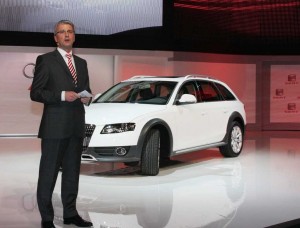After years of debate, luxury maker Audi has finally won approval from parent Volkswagen AG to build a new North American assembly plant that could help fuel its record growth in the U.S. and other markets.
But the maker of products like the A6 and Q7 has decided to locate the facility in Mexico, rather than the United States, it has announced.
“As an established carmaking location, Mexico offers an excellent economic basis for Audi production operations,” said Audi Chairman Rupert Stadler. “Mexico is one of the world’s top ten automotive locations and offers a blend of tradition and experience.”
Mexico now has significantly more production capacity than its own market needs might justify, industry analyst note, and continues to gain more rapidly. Nissan recently announced a multi-billion-dollar project near Aguas Calientes, with alliance partner Mercedes-Benz considering a nearby site. And Honda earlier this month broke ground on a new plant in the country that will produce the subcompact Fit, among other models.
Low labor costs averaging about $8 an hour – compared to more than $50 in the U.S. – certainly work to Mexico’s advantages, industry officials suggest. But there are other pluses, including the country’s central location, which makes it easy to ship finished vehicles to both North and South America. And Mexico has more automotive free trade agreements in place than any other country in the world but Israel.
The debate over where to place the new Audi plant had reportedly held up a final decision on a factory much needed by the VW subsidiary. Long a laggard in the luxury market, Audi is now in close pursuit of global rivals Mercedes-Benz and BMW. It is further behind in the U.S., but has been setting a series of sales records over the last several years and hopes that the new factory will give it further momentum.
It should certainly permit the automaker to sidestep the disadvantages of producing vehicles in the so-called Euro-zone, which means facing serious cost penalties due to lopsided exchange rates.
Audi Chairman Stadler had argued in favor of placing the new factory in Mexico. Top executives at VWAG had wanted something in the States, possibly near to the Volkswagen brand’s new assembly plant in Chattanooga, Tennessee.
What’s clear is, “We will have additional demand for production which we cannot cover from Ingolstadt and Neckarsulm (Audi’s main German plants) from 2015, 2016,” said Stadler.
Details of the new plant have yet to be released, so it is not clear if it will go into a location nearby the VW factory in Puebla that produces models such as the third-generation Beetle.
A statement by Mexico’s Economic Minister Bruno Ferrari suggested Audi will invest as much as $2 billion in its new facility.
But Stadler countered that “We are talking about 150,000 units (of capacity). That does not require $2 billion.”
The plant will assist Volkswagen in its quest to boost U.S. sales to 1 million by 2018 – including 200,000 Audis and 800,000 VW-branded vehicles. The maker is also seeking to sell 10 million vehicles worldwide by that year, which it believes would position it as the industry’s global sales leader.

